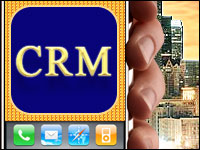
In-application features have been all about revenue so far, but as the technology evolves and mobile becomes ever more entrenched in consumers’ psyches, the in-app phenomenon will likely spread to other forms of customer outreach as well, including messaging.
First, though, let’s talk about the money.
Some 43 percent of mobile gamers have made purchases via an in-app mechanism, according eMarketer.
Gartner recently captured the power of in-app purchasers on an even grander scale: It predicts that in-app purchases will account for a full 48 percent of app store revenue by 2017, up from 11 percent in 2012.
Following the Money Trail
Any marketer worth his salt will, of course, follow this money trail.
“The in-app model will continue to drive in-app revenue in the near future” — especially for certain types of applications, Tom Edwards, senior vice president for digital strategy at The Marketing Arm, told CRM Buyer.
Gaming apps, as noted above, are driving in-app microtransactions.
“There’s been a shift over the past year toward free-to-play, or ‘freemium,’ apps that drive incremental revenue through in-app purchases to continue the experience,” Edwards observed.
Such freemium models have their critics, but they are counterbalanced by other factors, such as the small subsets of in-app purchasers who are actually subsidizing for a majority of the other users, he continued.
‘Immediate or Long-Term Value’
At bottom, though, “the key for any app to drive revenue is that the application needs to provide some form of relevant utility and any enhancing experience,” Edwards said. “The in-app purchase needs to deliver immediate or long-term value for the app user.”
So that is the straightforward case for in-app purchasing. Now, though, marketers are pushing its boundaries, in part because consumers have become comfortable with the technology — and in part because the money trail is expected to dry up in years to come.
Gartner also predicted that after in-app purchases hit their amazing growth spurt by 2017, the volumes will start to drop as smartphones saturate the market.
A Twist on the Familiar
Some marketers are using in-app functionality to offer gifts, said Teri Llach, CMO ofBlackhawk Network.
The opportunity for that is large, Llach told CRM Buyer, “because major brands can utilize gifting apps — which are among the most active consumer touch points — as a way to deepen engagement and brand loyalty.”
It is a step away from basic banner advertising, she added.
“We’ve seen industry growth through e-gifting across all channels,” she explained. “There is a significant opportunity for platforms and companies to present customers with added e-gifting options right from their mobile device, which could lead to a consumer purchase.”
Compelling Use
It is a big step, at least for many consumers, from making a 99 cent token purchase in a game to, for example, a US$35 purchase of new headphones within an app. While apps are hardly novel developments anymore and mobile purchasing is hitting robust volumes, consumers have not taken that particular step.
This is an issue that some app developers now are working on — or at least contemplating, noted John Thomas, director of product management at Embarcadero.
“One of the more challenging aspects of app distribution is getting users to try it,” Thomas told CRM Buyer. “We have seen some unique approaches to this challenge recently and believe there are many more creative ways to compel in-app purchases.”
One interesting area brewing, Thomas added, is the interaction between mobile devices and other traditionally embedded systems, such as wearables, in-house automation and in-car infotainment.
“Most of these systems can be easily controlled by mobile devices but are now becoming app-ready with Android, which will only improve on the connectivity capabilities for apps,” he explained.
It’s an interesting and exciting time to be an app developer, Thomas concluded.
Personalized Messaging
Another use for an in-app platform is personalized messaging, perhaps married with some geofencing capabilities. IBM is exploring this possibility via its recent acquisition of Xtify, a provider of mobile messaging tools. Among other things, Xtify’s technology can deliver personalized offers via in-app mobile messages and push notifications.
“That is one of the things that attracted us to Xtify,” Chris Wong, vice president of IBM Digital Marketing, told CRM Buyer. “We can engage with a mobile user based on that person’s interest and intent and where he is.”
SMS can do that too, of course, but today’s mobile consumer needs to be engaged in a variety of ways, he said.
“We see a lot of potential for in-app messaging,” Wong concluded.
























































